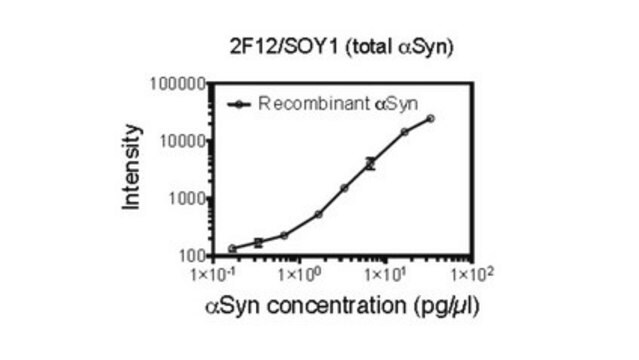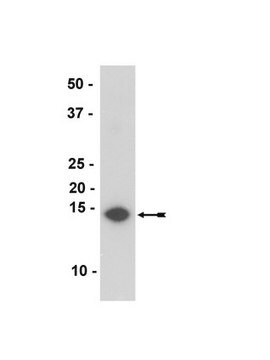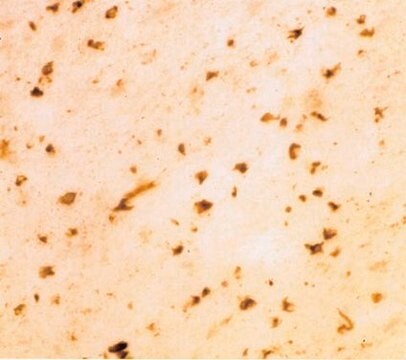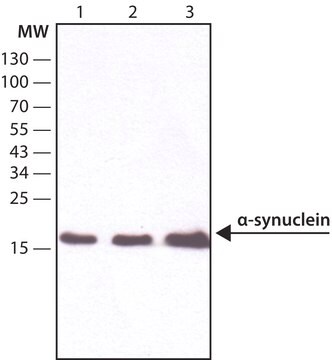MABN1817
Anti-α-Synuclein (SNCA) Antibody
mouse monoclonal, 2F12
Synonyme(s) :
Alpha-synuclein, NACP, Non-A beta component of AD amyloid, Non-A4 component of amyloid precursor, Synuclein alpha-140
About This Item
Produits recommandés
Nom du produit
Anti-α-Synuclein Antibody, clone 2F12, clone 2F12, from mouse
Source biologique
mouse
Niveau de qualité
Forme d'anticorps
purified immunoglobulin
Type de produit anticorps
primary antibodies
Clone
2F12, monoclonal
Espèces réactives
rat, human, mouse
Technique(s)
ELISA: suitable
immunocytochemistry: suitable
immunohistochemistry: suitable (paraffin)
immunoprecipitation (IP): suitable
western blot: suitable
Isotype
IgG2bκ
Numéro d'accès NCBI
Numéro d'accès UniProt
Conditions d'expédition
ambient
Modification post-traductionnelle de la cible
unmodified
Informations sur le gène
human ... SNCA(6622)
Description générale
Spécificité
Immunogène
Application
ELISA Analysis: A representative lot (0.4 µL in 30 µL buffer/well for coating) captured recombinant human α-synuclein (0.2-40 ng/mL) in a sandwich ELISA application utilizing clone SOY1 (Cat. No. MABN1818; preconjugated with Sulfo tag) as the detection antibody (Courtesy of Tim Bartels, Ph.D., Brigham and Women′s Hospital, Boston, MA, U.S.A.).
Immunocytochemistry Analysis: A 1:1,000 dilution from a representative lot immunostained primary mouse cortical neurons (Courtesy of Tim Bartels, Ph.D., Brigham and Women′s Hospital, Boston, MA, U.S.A.).
Immunohistochemistry Analysis: A 1:11,110 dilution from a representative lot immunostained Lewy bodies (LBs) in striatum tissue sections from Parkinson′s diseased (PD) human brain (Courtesy of Tim Bartels, Ph.D., Brigham and Women′s Hospital, Boston, MA, U.S.A.).
Immunoprecipitation Analysis: 4 µL from a representative lot immunoprecipitated α-synuclein from 50 µg of HEL human erythroleukemia cell lysate (Courtesy of Tim Bartels, Ph.D., Brigham and Women′s Hospital, Boston, MA, U.S.A.).
ELISA Analysis: A representative lot captured both endogenous α-synuclein (αS) from human cortical homogenate, as well the exogenously expressed wild type and familial PD (fPD) αS mutants (A30P, E46K, H50Q, G51D, A53T) from sytosolic extracts of transfected M17D human neuroblastoma cells in a sandwich ELISA application utilizing clone SOY1 (Cat. No. MABN1818; preconjugated with Sulfo tag) as the detection antibody (Dettmer, U., et al. (2015). Nat. Commun. 6:7314).
ELISA Analysis: A representative lot captured both pre-aggregated fibrillar recombinant α-synuclein as well as partially purified Lewy bodies (LBs) from a DLB (dementia with LBs) patient with or without prior sample denaturing by boiling with 2% SDS in a sandwich ELISA application utilizing clone SOY1 (Cat. No. MABN1818; preconjugated with Sulfo tag) as the detection antibody (Dettmer, U., et al. (2015). Nat. Commun. 6:7314).
Immunocytochemistry Analysis: A representative lot detected cytosolic localization of endogenous rat α-synuclein (αS) and exogenously overexpressed human αS by fluorescent immunocytochemistry staining of 4% paraformaldehyde-fixed, 0.25% Triton X-100-permeabilized primary rat neurons and transfected M17D human neuroblastoma cells (Dettmer, U., et al. (2015). Nat. Commun. 6:7314).
Western Blotting Analysis: A representative lot detected monomeric α-synuclein (αS) as well as αS multimers (αS60, αS80 and αS100) in extract from disuccinimidyl glutarate (DSG) cross-linked mouse brain bits, human iPSCs (both S A53T mutant and corrected isogenic line) and ESCs (both wild-type and genetically engineered isogenic αS E46K line). A significantly reduced αS60 level was seen with A53T and E46K mutants (Dettmer, U., et al. (2015). Nat. Commun. 6:7314).
Western Blotting Analysis: A representative lot detected monomeric α-synuclein (αS) as well as αS multimers (αS60, αS80 and αS100) in cytosolic extracts from disuccinimidyl glutarate (DSG) cross-linked primary rat neurons, as well as human HEL erythroid leukemia and M17D neuroblastoma cells (Dettmer, U., et al. (2013). J. Biol. Chem. 288(9):6371-6385).
Neuroscience
Qualité
Western Blotting Analysis: A 1:1,000 dilution of this antibody detected α-synuclein in 10 µg of human fetal brain tissue lysate.
Description de la cible
Forme physique
Stockage et stabilité
Autres remarques
Clause de non-responsabilité
Vous ne trouvez pas le bon produit ?
Essayez notre Outil de sélection de produits.
En option
Code de la classe de stockage
12 - Non Combustible Liquids
Classe de danger pour l'eau (WGK)
WGK 1
Point d'éclair (°F)
Not applicable
Point d'éclair (°C)
Not applicable
Certificats d'analyse (COA)
Recherchez un Certificats d'analyse (COA) en saisissant le numéro de lot du produit. Les numéros de lot figurent sur l'étiquette du produit après les mots "Lot" ou "Batch".
Déjà en possession de ce produit ?
Retrouvez la documentation relative aux produits que vous avez récemment achetés dans la Bibliothèque de documents.
Notre équipe de scientifiques dispose d'une expérience dans tous les secteurs de la recherche, notamment en sciences de la vie, science des matériaux, synthèse chimique, chromatographie, analyse et dans de nombreux autres domaines..
Contacter notre Service technique








